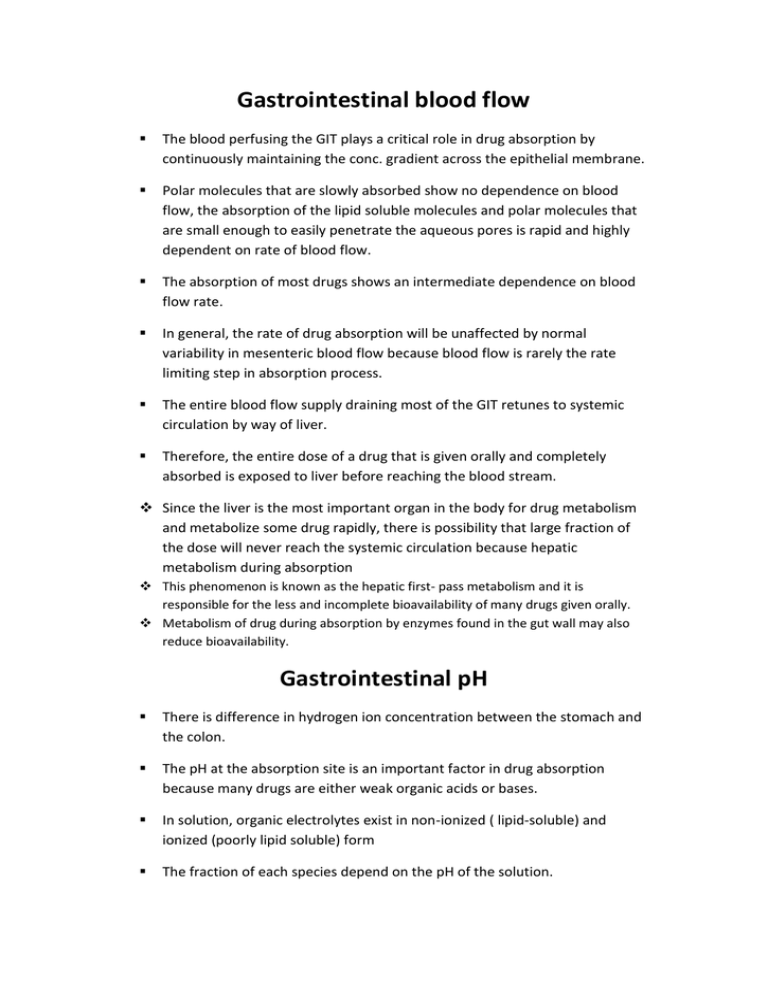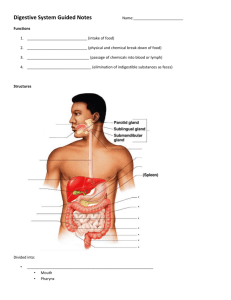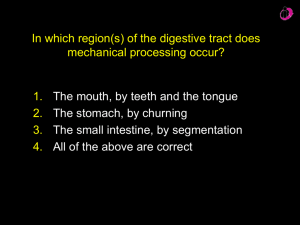Gastrointestinal blood flow
advertisement

Gastrointestinal blood flow The blood perfusing the GIT plays a critical role in drug absorption by continuously maintaining the conc. gradient across the epithelial membrane. Polar molecules that are slowly absorbed show no dependence on blood flow, the absorption of the lipid soluble molecules and polar molecules that are small enough to easily penetrate the aqueous pores is rapid and highly dependent on rate of blood flow. The absorption of most drugs shows an intermediate dependence on blood flow rate. In general, the rate of drug absorption will be unaffected by normal variability in mesenteric blood flow because blood flow is rarely the rate limiting step in absorption process. The entire blood flow supply draining most of the GIT retunes to systemic circulation by way of liver. Therefore, the entire dose of a drug that is given orally and completely absorbed is exposed to liver before reaching the blood stream. Since the liver is the most important organ in the body for drug metabolism and metabolize some drug rapidly, there is possibility that large fraction of the dose will never reach the systemic circulation because hepatic metabolism during absorption This phenomenon is known as the hepatic first- pass metabolism and it is responsible for the less and incomplete bioavailability of many drugs given orally. Metabolism of drug during absorption by enzymes found in the gut wall may also reduce bioavailability. Gastrointestinal pH There is difference in hydrogen ion concentration between the stomach and the colon. The pH at the absorption site is an important factor in drug absorption because many drugs are either weak organic acids or bases. In solution, organic electrolytes exist in non-ionized ( lipid-soluble) and ionized (poorly lipid soluble) form The fraction of each species depend on the pH of the solution. Since the GI barrier is much more permeable to unchanged, lipid soluble solutes, a drug may be well absorbed from one part of GIT where a favorable pH exists, but poorly absorbed from another part, where a less favorable pH is found. The absorption of weak basic drugs such as antihistamines and antidepressant is favored in the small intestine where such drugs exist in nonionized form. On the other hand the acidic gastric fluids tend to retard the absorption of weak bases but promote the absorption of weak bases but promote the absorption of weakly acidic drugs such as a sulfonamide and non- steroidal anti-inflammatory drugs. The pH of the gastric fluid varies considerly, gastric secretion have a pH of less than 1, but the pH of the gastric content from 1-3 because of dilution and diet. The pH of the stomach is elevated after meal, fasting tend t decrease the pH of gastric fluids. Disease may also influence the pH of the stomach. The average gastric pH is significantly lower in patients with duodenal ulcer than healthy individuals. Fats and fatty acids in the diet have been found to inhibit gastric secretion. A major clinical effect of antispasmodic drugs e.g. atropine, H2-blockers like cimetidine and ranitidine, is a reduction of gastric secretions, is commonly found with many other drugs. Antacid products are widely used for the purpose of neutralzing gastric acidity and elevating the pH of gastric content. Disease drug related changes in gastric pH may influence the dissolution, stability, and/or absorption of certain drugs. Gastric emptying and gastric motility Factors that promote gastric emptying tend to increase absorption rate of drugs. The converse is equally true and equally important. Slow gastric emptying can seriously delay the onset of action of drugs such as analgesics or sedatives in situation requiring prompt clinical response. Prompt gastric emptying is also important for drugs that are unstable in stomach fluids because of low pH or enzyme activity. For example the extent of degradation of penicillin G after oral administration depends on its residence time in stomach and on the pH of the stomach fluids. Gastric emptying often appears to be an exponential process. Standard low bulk meals and liquids are transferred from stomach to the duodenum in an apparent first order fashion, with half- life of 20-60 minutes in healthy adult. However many factors can influence the rate of this process. Gastric emptying is reduced by: 1- fats and fatty acids in the diet 2- high concentration of electrolytes 3- hydrogen ion 4- high viscosity or bulk 5- mental depression ( emotional stress) 6- lying on the left side 7- diseases such as gastroenteritis, gastric ulcer 8- many drugs such as atropine, narcotic analgesics …………..etc. Gastric emptying is promoted by: 1- Fasting or hunger 2- Alkaline buffer solution 3-Anxiety 4- Lying on the right side 5- Diseases such as hyperthyrodisim 6- drugs such as metoclopromaide which is potent antiemetic Gastric emptying of liquids is much faster than that of solid food or solid dosage forms The motility of the small intestine as indicated by small bowel transit time also plays a role in drug absorption. The mean transit time of unabsorbed food residues or insoluble granules through the human small intestine is estimated to be about 4 hours. Propantheline and similar drugs significantly increase small bowel transit time, where metoclopramide accelerates transit time through small intestine. The extent of absorption of drugs that are incompletely absorbed may be dependent on intestinal motility. Effect of food on drug absorption In general, GI absorption is favored by an empty stomach, however, one should not give all drugs on empty stomach, some irritating to stomach and should be administered with or after a meal to reduce adverse effects. The absorption rate but not the extent of absorption of most drugs is reduced in presence of food. The effect of food on the absorption rate but not the extent of absorption The absorption of few drugs is actually promoted when administered following a meal. For example the absorption of riboflavin is significantly greater than usual when it is given after standard breakfast as shown in table. Dose(mg) Percent abs Fasting Percent abs. non-fasting 5 48 % 62 % 10 30 % 63 % 15 16 % 61 % The bioavailability of chlorothiazide is doubled when taken immediately following a meal compared to that found fasting subjects. Malabsorption It may be defined as any disorder with impaired absorption of fat, carbohydrates, minerals, water, protein and vitamins Drugs induced malabsorption has been observed after administeration of different drugs including neomycin, phenytoin, and certain antineoplastic agents such as methotrexate.







